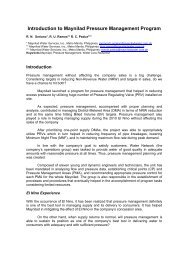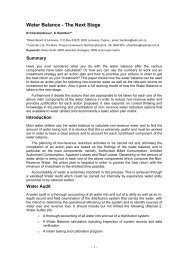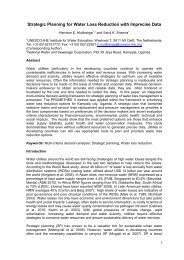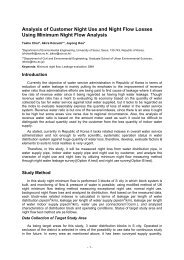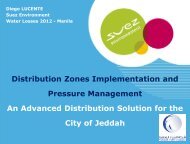The Challenge of Reducing Maynilad's Non ... - Iwa-waterloss.org
The Challenge of Reducing Maynilad's Non ... - Iwa-waterloss.org
The Challenge of Reducing Maynilad's Non ... - Iwa-waterloss.org
Create successful ePaper yourself
Turn your PDF publications into a flip-book with our unique Google optimized e-Paper software.
With more than 100 repair teams available (outsourced to accredited contractors), Maynilad was<br />
able to increase its annual total number <strong>of</strong> repairs from 18,000 in 2009 to 40,000 repairs starting<br />
2010.<br />
In February 2010, the Leak Repair Control Center (LRCC) was established under Central NRW<br />
division to monitor and centralize leak repair operations. <strong>The</strong> tasks <strong>of</strong> the LRCC are to<br />
consolidate all leak complaints, monitors contractors accomplishments and to analyze how to<br />
further improve job order management, increase leak repair output and reduce leak repair<br />
runtime.<br />
7.3.2. Pipe Inspection <strong>of</strong> Large Diameter Pipes<br />
Before, the impression was Maynilad’s primary distribution system (PDS),large diameter pipes<br />
with 350 mm and above, have no losses, because there were no surfacing leaks and the<br />
capability and equipment to detect leaks were very limited and methods <strong>of</strong>ten used were<br />
obsolete.<br />
It was further aggravated by the existing conditions we have in Manila: noisy environment, and<br />
heavy traffic which compounded the background noise being captured by the conventional leak<br />
detection equipment. What was making it more difficult was the unreliable and not updated<br />
pipeline maps.<br />
In March 2010,Maynilad engaged Pressure Pipe Inspection Company,(PPIC) a Canada based<br />
company,for a Leak Location Services and Equipment Rental agreement, aimed to<br />
check,inspect,and locate leaks on Maynilad’s selected PDS using the Sahara System-a state<strong>of</strong>-<br />
the art leak detection technology that accurately detects leaks, pockets <strong>of</strong> trapped gas and<br />
structural defects in large diameter pipes.<br />
It was the first actual application <strong>of</strong> this technology in the Philippines and in this region. Prior to<br />
the start <strong>of</strong> the project, four Maynilad young engineers, were sent and trained in Canada. Follow<br />
through training was done here in Manila as part <strong>of</strong> the service provided by PPIC.<br />
<strong>The</strong> established DMAs on the SDS and TDS enabled Maynilad to measure water losses in the<br />
PDS. Maynilad has a total <strong>of</strong> 300 KM <strong>of</strong> PDS with size ranging from 300 mm DN to 3200 mm<br />
DN.Water audits <strong>of</strong> the identified segments were conducted and the volume <strong>of</strong> water loss was<br />
estimated to be substantial enough to supply<br />
adjacent expansion and underserved areas.<br />
Subsequently, Sahara inspection was carried out<br />
and findings reveal significant losses due to leaks,<br />
illegal connections, unknown laterals, not<br />
decommissioned old pipes and other network<br />
anomalies.<br />
To-date Maynilad is operating 2 units <strong>of</strong> Sahara,<br />
primarily in the high NRW areas <strong>of</strong> Central Manila<br />
and the operations are contributing significantly in<br />
the recovery <strong>of</strong> water being lost in the system. <strong>The</strong><br />
number <strong>of</strong> leaks repaired on the PDS in 2010 has<br />
significantly increased four times it was in 2009.







